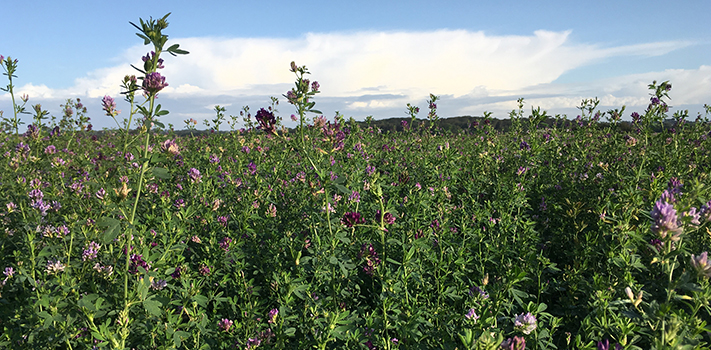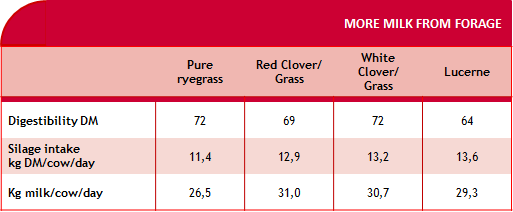Homegrown protein for increased milk and meat production
Growing more high protein forage crops like alfalfa and clovers, offers milk and meat producers a greater control over feed cost and climate impact. Cost control should be a priority for all milk and meat producers given the uncertainty of commodity price volatility. In addition, homegrown protein is also a more sustainable solution that offers a positive environmental and climatic impact.
20-03-2020

Ruminants have the fantastic capacity to exploit energy and protein from legumes, because they can break down the cell wall of these plants. Both alfalfa and clovers offer a homegrown protein solution for milk and meat producers.
The case for homegrown protein
Homegrown protein will offer farmers important benefits to maintain an economic and green production:
- Autonomy and self-sufficiency at the farm level - less dependency on fluctuating world market prices for concentrates
- Positive environmental and climatic impact: Carbon sequestration, improved soil structure, nitrogen fixation and biodiversity
- And lately also the individual nations sovereignty for human food supply
Protein autonomy in mik and meat production
Milk and meat production is largely based on 1) forage crops used for grazing and for conservation as silage or hay and 2) bought-in protein sources. These forage crops are already important sources of protein and cover the major part of the need. But we can go a step further and increase the homegrown part of the protein and thereby decrease the imported part correspondingly. This will help farmers be more self-sufficient and reduce the reliance on bought-in protein sources. At the same time this solution offers advantages in terms of soil fertility and pest control.
The main tools to improve protein autonomy
When you want to increase the ratio of homegrown protein to be self-sufficient there are things to be considered.
Species and mixture composition
The first consideration is the choice of species. Silage maize has a significantly lower protein content than both grasses and clover-grass mixtures. In grassland the share of leguminous species like alfalfa and clover can be increased to improve the protein content and at the same time lower the need of synthetic nitrogen fertilizer needed to achieve a given level of dry-matter.
Grassland management
Cutting or grazing at the optimal development stages of plant development is essential for maximizing outcome of energy and protein. This goes for grass grown in pure grass mixtures or straights as well as for mixtures of grasses and legumes.
Improving the protein and energy contribution of grasses
Apart from cutting at the right moment, the grasses can contribute even more to the protein and energy yield of the forage. In DLF we focus on the fiber fraction of the grasses and breed for increased fiber digestibility in our varieties. This leads to an increased amount of energy per kg dry matter. And also a higher intake, which results in higher animal output and better earnings; we call it DLF Fiber Energy.
Are clover-grass and alfalfa sustainable solutions?
Legumes are providing locally grown protein, limiting the import of protein and emissions from transport of overseas substitutes. Legumes fixate nitrogen from the air, reducing the need for fertilising the soil. That has a positive climatic impact since production of nitrogen fertiliser is highly energy consuming. The contribution to improved soil structure and diversity is also considerable.
DLF solutions
DLF has built a strong portfolio in all important temperate forage legumes:
- DLF White clover - ranging from small leaved, medium and large-leaved types
- DLF Red clover – with an important renewal of the portfolio in recent years
- DLF Alfalfa – an extremely successful portfolio expanding in several countries. Winter-hardy types also available.
To fit your need, DLF grasses, clovers and alfalfa are bred and combined in mixtures to fit the local environmental conditions while securing a high productivity on forage pastures and a high forage value.

Source: Comparison of Grass and Legume Silages for Milk Production. 2. In Vivo and In Sacco Evaluations of Rumen Function
Dewhurst, R.J. et al. Journal of Dairy Science, Volume 86, Issue 8, 2612 - 2621
